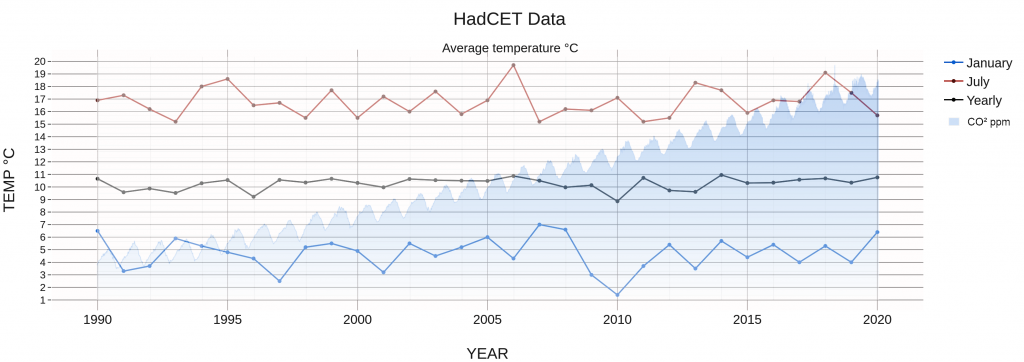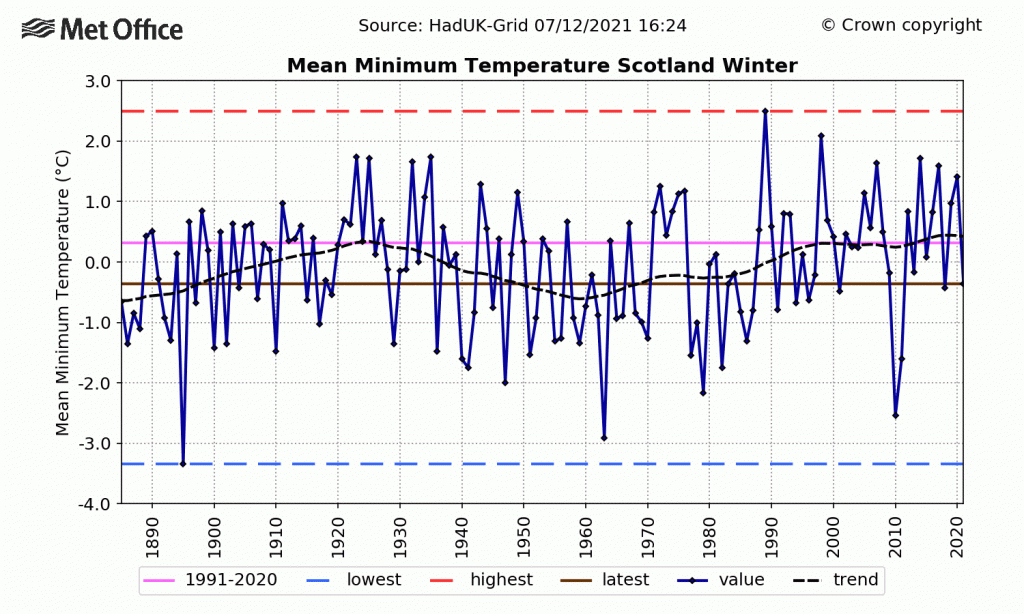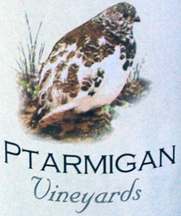What hope for the ptarmigan’s future? I doubt most of you have ever asked that question. But as I belatedly watched Winterwatch yesterday, the ever-pessimistic Chris Packham bemoaned their decline in numbers and warned of their imminent extinction, of course due to climate change.
The threat of extinction is, in fact, purely local for a circumpolar bird species like this, but I found myself wondering how they managed to survive in Scotland since the ice age through the holocene optimum, and the Minoan, Roman and mediaeval warm periods, all of which were hotter than today.
In fact my first port of call in answering that question was the climate record itself, which isn’t quite what you’d assume. For according to the Met Office, England at least seems to have miraculously avoided the catastrophic warming destroying the rest of the world altogether, despite our government’s imposing some of the most draconian mitigation measures:
As you see, there is no trend at all in central England’s average temperature for the last thirty years, despite the steady rise in CO2 (in blue). “No causation without correlation.” Or else England must be a freak carbon-free zone! You ought to keep this chart in mind whenever your friend tells you it’s so much hotter than it was in his youth, or when crop yields, changes in animal populations or, indeed, anything else in England is blamed on climate change.
I’ve not found an equivalent graph for Scotland, but since the problem for ptarmigans appeared in Winterwatch to be linked to the lack of the snow in which, in their winter plumage, they are so well camouflaged, here is a chart of Scottish winter minimum temperatures:
Here we have no overall trend since 1890, that is for 130 years since the industrial world was young (and most of it in Britain), and the 1920s were no colder than this century has been. Ptarmigans have been here before, even within recent memory.
According to Natural England, the ptarmigan is one of several species that disappeared from England between Roman times and 1800. The ptarmigan and the capercaillie were lost towards the end of that time, owing (they say) to “overhunting and habitat loss.” In fact the capercaillie disappeared from Britain altogether, and had to be re-introduced from Sweden. And it became extinct whilst the Little Ice Age was only beginning to end, so that excess heat is certainly not the whole story.
As far as I can tell, the ptarmigan held out in their highland fastnesses. But their late disappearance in England means that they had been quite happy in our milder climate since the ice-age, even during the warm periods – or at least they had been quick to re-colonise from the cooler north if they had fled the sun when there were vineyards in the north or pelicans in the south.
So it seems to me quite possible that many factors, apart from climate change, are to blame for any decline in ptarmigan numbers. But let us suppose, for a moment, that the present warm spell pinches their ability to occupy their Scottish niche, so that they do indeed disappear from our shores. Since the climate has changed constantly over history, such local extinctions on northern temperate islands are absolutely normal. We lost mammoths and woolly rhinos from London long ago.
The recent emergence of mediaeval villages from under alpine glaciers proves that it was warmer than it is now a few centuries ago. It is said that those glaciers disappeared altogether in the warm periods – how else did Hannibal get tropical elephants across the Alps? You can bet that arctic species were less common here in mediaeval times, and that those that could migrate were seen again during the Little Ice Age. For less mobile species, climate change can indeed be a ratchet that depletes those species on island territories. We have species that Ireland lacks (such as snakes) only because Britain had land bridges when the world was colder.
Should ptarmigan really disappear from Scotland because it becomes too warm, they could always be reintroduced artificially when it gets colder again. Maybe it would be a pity not to be able to see them without crossing the sea, but the same is true for wolves and wisent (European bison), and until recently for storks and beavers.
It is only a “tragedy” in the Chris Packham mould if one believes that it is mankind that has made Britain warmer, and that it is irreversible. When he appeared on Room 101, the species he wished could be eradicated was, rather predictably, Homo sapiens. Does misanthropy lead to belief in anthropogenic global warming, or vice versa? In David Attenborough’s case, at least, it seems to have been the former.
Be that as it may, there is increasing doubt about the anthropogenic global warming hypothesis anyway, and as I have shown it looks as though rumours of Britain’s burning up have, like most of the climate change religion’s claims, been exaggerated. God, it appears, just likes to ring the changes. It seems to me there is plenty of useful conservation to be achieved by attuning our day to day living more to nature’s ways. Moaning about the weather, and worse still trying to change it, are probably the least useful exercises.





The Central England Temperature series is as understandable as it is inconvenient for climate alarmists. Whenever I mention the series and it’s obstinate lack of warming people seem horrified and dismiss the series as some conspiracy theory. As in Ross Clark’s “The Denial” if the data doesn’t show a warning trend, there’s obviously something wrong with the data because temperatures are increasing.
It’s rather like the fact that although vaccine mandates don’t work, they’re useful because they encourage more people to get vaccinated. Vaccines are safe and effective, even if they don’t work and kill people, so the facts must be suppressed so as not to encourage the anti-vaxxers’ misinformation…
Stop press: another Winterwatch episode, and another feature on ptarmigan decline because of man-made climate change (said Yollo). He showed a chart of the declining numbers, which clearly demonstrated a massive decline… up to 2000, that is. After that the numbers have stayed at the same overall low level, with some degree of recovery around 2010, which might well be due to the couple of hard winters around that time.
But to my eyes, the overall levelling off since 2000 closely matches the lack of warming on the average temperature graphs. The chart actually suggest that the decline, and the warming, bottomed out (and topped out, respectively) 20 years ago. But neither emissions nor atmospheric CO2 have stopped rising since then, which makes the link between fossil fuels and ptarmigan numbers difficult to justify.
What is interesting is that the presenter didn’t notice any of that: he saw only the decline. Because he believes in global warming, he sees what he expects to see. Isn’t the science (of psychology) wonderful!wonderful